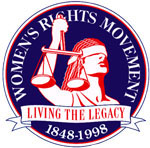
|
Although
American women won the right to vote in 1920, broader economic and social
change has been a longer time coming, and the pace of progress has often
been uneven.
In the United States during the 1960s, there began a period of substantial
social change; in women's issues, the result was a phenomenon known
as the women's movement. Influenced by the success of the civil rights
movement for racial equality and other progressive currents sweeping
the nation during the 1960s and 1970s, a wide array of organizations
and lobbying groups urged full equality for American women as well.
The call was not only for a fundamental revision of American institutions,
customs and values, but also for a revolution in consciousness -- in
the minds of women as well as men -- and especially in the way women
thought about themselves. Not everyone welcomed the resulting changes,
as evidenced by the formation of a number of organizations intent on
countering what they viewed as unrestrained feminism.
But whatever the perspective, there can be no doubt the changes have
been telling. American women are living very different lives today than
they did in the 1950s and earlier. (The
Changing Role of Women in the United States. U.S. Department of State,
IIP Electronic Journal) |
Women
and the Economy 2010: 25 Years of Progres but Challenges Remain
U.S. Congress Joint Economic Committee. August 2010.
On August 26, 2010, Americans will celebrate the 90th anniversary of
the ratification of the 19th amendment, which granted women the right
to vote and led to their increased participation in our political system.
In 1984, Geraldine Ferraro shattered the political glass ceiling by
becoming the first woman nominated to a national ticket and ushered
in a new era of political leadership for
women. Over the last quarter century, women have become a powerful political
force, both as voters and as elected leaders. Did that political benchmark
have implications for women’s economic well-being? Data compiled
by the Joint Economic Committee suggest that the answer is yes.
 |
Cathy
L. Lanier is Washington's first permanent female police chief.
(© AP Images) |
U.S.
Women Making Strides in Education, Entrepreneurship
A
demographic profile of women in the United States
American women -- 152 million or 51 percent of the U.S. population --
increasingly are making their influence felt in all spheres of American
life. And the month of March -- National Women's History Month -- is
a fitting time to measure the progress women are making in American
society.
Recognizing that education is their ticket to economic success, women
now graduate high school at rates higher than those of men -- 87 percent
for women; 85 percent for men. In the age range of 25 to 29 years, 32
percent of women compared to 25 percent of men obtained bachelor's degrees
or higher in 2005. On the other hand, a higher proportion of males in
the general population had a bachelor's degree or higher (28.9 percent
compared with 26.5 percent of women). (America.gov, 25 March 2008.)
Women's
History, Accomplishments Celebrated Every March
2008 Women's History Month theme is Women's Art: Women's
Vision
In 1981, the U.S. Congress passed a resolution establishing
National Women's History Week. In 1987, Congress expanded the week to
a month, and has since passed such a resolution every year. Congressional
action is followed by a U.S. presidential proclamation declaring March
as Women's History Month. (America.gov,
29 February 2008.)
National Museum of Women in the Arts Celebrates 20 Years
Anniversary exhibition focuses on women Renaissance, Baroque pioneers
Throughout its existence, the National Museum of Women in the Arts (NMWA)
has been called on to justify its mission in a way that 'other established
museums don't have to, 'says Jordana Pomeroy, co-curator of the NMWA's
new exhibition, 'Italian Women Artists from Renaissance to Baroque.'
As the world's only museum dedicated solely to the works of women artists,
the NMWA is accustomed to critics who question the need for such a facility
and who insist that art should not be viewed through the prism of an
artist's gender. But in interviews, both Pomeroy and the NMWA's director
of communications, Howard White, said the museum is needed. (America.gov,
28 March 2007.)
|
|
Women
of Influence
This
publication offers a glimpse at how women in one country the United
States have helped shape their society. These notable women from the
Native-American Sacagawea,
who guided white settlers through a vast wilderness, to Sojourner
Truth, who fought for the end of slavery and equal rights for all;
to Rosalyn
Yalow, winner of the Nobel Prize in Medicine for her research into
a new technique for measuring substances in the blood believed that
they had a contribution to make and did not shrink from the obstacles
in their way. This account of their accomplishments is a reminder that
all societies benefit from the talents and expertise of their women.
Making
a Difference in the U.S.A - Women in Politics (March
2008) (PDF file, 1.44MB)
This publication offers the stories of women who believed that they
could make a difference by participating in politics and government,
and forged ahead to do so. They are not famous, like U.S. presidential
candidate Hillary Clinton, and they are not serving at the top, like
Presidents Michelle Bachelet of Chile or Ellen Johnson-Sirleaf in Liberia.
But, just like Bachelet, Clinton, and Johnson-Sirleaf, they have overcome
obstacles to get where they are. They have acquired experience in running
for election, being an effective policy-maker, and in persuading elected
officials to support their cause.
|



